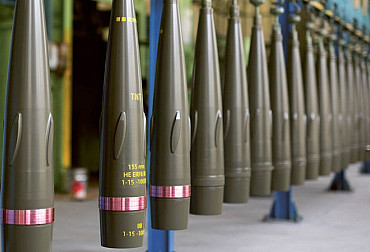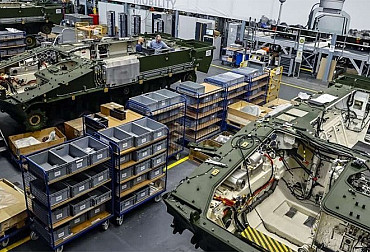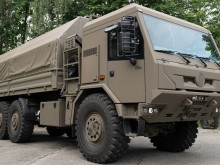The end of the Mi-24/35 helicopter legend in the Czech Air Force
All of us who flew the Mi-24 Hind were able to symbolically reminisce on Saturday, October 14. A farewell to these machines was organized by the 22nd Helicopter Air Force Base in Náměšt' nad Oslavou, where 250 people came from pilots and technicians who had flown the "twenty-four" for several generations. These machines served 45 years in the Czechoslovak and later Czech army and became a legend, although they never saw deployment in a foreign operation.

"It was a tearjerker," says Frantisek Dvorak, a former Mi-24 pilot with the 11th Helicopter Regiment in Pilsen. "Something with which a piece of life was connected is leaving," Dvořák adds, while two Mi-24Vs circle overhead with a dynamic demonstration. They fly some similar elements to those flown in the early 1990s by Lieutenant Colonel Dvorak, who led a "box" of four machines flying at air days as part of the then display team. The fifth machine then performed as a solo display.
At that time I flew with him in the crew as a pilot-operator. I also flew a couple of flights in a solo helicopter with Bohuslav Dvorak, the squadron commander at the time. Sometimes elements were flown literally over the top. Unlike a fighter, the spectrum of aerobatics on the Mi-24 is limited, with the biggest challenge being the roll. This could be flown with the machine perpendicularly down and the crew hanging in the courts, except for the flight engineer. He sat in the tunnel behind the pilot on some improvised pedestal and had to hold on tight.
Dvorak and the older pilots also experienced cash at Kříženec near the western border of Czechoslovakia. Although the airmen were serving the communist regime, no one thought much about it at the time. It was all about flying. And this was literally over the top, according to the memories of veterans, because the crews were literally chasing helicopters of NATO countries, our then adversary, between the hills on both sides of the state border.

From the "Delta" to the improved "V's"
The first version of the Mi-24 (the so-called "A") began serial production in the Soviet Union in 1972. The "twenty-four" as we know it, i.e. the D version, where the crew sits in tandem behind each other, dates back to 1976 and two years later it appeared in the Czechoslovak army. According to the portal Vrtulnik.cz, the first group of pilots and technicians were retrained at the airport in Frunze in Kyrgyzstan (now Bishkek) and on 24 August 1978 the first four machines flew to Prostejov's 51st Helicopter Regiment.
In December 1985, the upgraded Mi24Vs began arriving at the 11th Helicopter Regiment in Pilsen, Bory. A total of 31 "Vs" were delivered by 1989, but after the collapse of Czechoslovakia, the Slovak Army acquired part of them. When the federation broke up, Slovakia received 10 "V", 9 "D" and one "DU".
The system of two helicopter regiments (the 11th moved from Bor to Plzeň-Lín) was maintained until the end of 1994, when the two units merged into the Přerov airbase. There, in the mid-1990s, the worst moments came for the twenty-fourths, when, due to the running out of service life of the equipment, the machines stood grounded and only limited flying took place.

The 1990s brought several waves of pilots leaving (I also left then), which managed to stabilize only in the next millennium. This was due to the low intensity of training and the fact that Mi-24s were not deployed in any real operation. A bit of a "band-aid" came during the floods in the summer of 1997, when the Mi-24s were used to recce flooded areas. Some of the crews, specifically the pilot-operators, also assisted on the Falcons, which were extremely busy.
At the beginning of the next decade, the Czech Republic received a total of 17 Mi-24Vs (export version of the Mi-35) as part of the Russian debt debasement. They differed from the basic V type with improved engines, exhaust gas coolers, internal and external lights modified for night vision use, NATO-standard camouflage, and better communications and navigation equipment. The pilot will especially notice that the cockpits are not described in Russian but in English.
Some of the machines ended up with the Afghan National Army in the past, and their fate is unknown today. Today, the decommissioned Mi-24s are heading to Ukraine, where, according to videos from the front, they immediately joined the fighting. However, their fate is also unknown.
The wilderness at the Křízenec
Since December 1984, Mi-24s have served in the State Air Defence System (PVOS) at the Zhůří and Kříženec airfields in western Bohemia, as well as at Moravské Budějovice, Božice and Malacky. Far more intense flying was, according to memoirs, at the western border, where Mi-24s intervened against OH-58C Kiowa and AH-1S Cobra helicopters of the US 2nd Redcatchers and SA 318C Alouette II (Astazou) of the Bundesgrenzschütz.
This historically almost uncharted activity was one of the greatest flying experiences the crews ever had. Flying in the mountain valleys, it was not uncommon for the pilots to break off a few meters and fly to the other side of the border. As were the occasions when the helicopter scooped up a treetop with its underside. The highlight of the wild unrestrained flying was the passes over the stand where there was a competition to see who could do it at the lowest possible altitude. "Sometimes it went too far, like in winter, when the Raduga machine (the bottom protrusion for controlling the rockets, author's note) picked up a mound that was created after shovelling snow from the stand," writes Bořivoj Čech, who was flying as a pilot-operator at the time, on the website Vrtulnik.cz.

After the fall of the Iron Curtain, the "aviation orgy" came to an end and cash turned into a boring wait when take-offs were rare. It was then served in Lini and Prostejov (since January 1995 in Přerov and Plzeň-Lini, where there was a cash swarm). The PVOS helicopters were intended for stray small aircraft, but took off against them on average once every few weeks. Although everyone knew that this form of cash was useless, the arrangement persisted until 31 December 1996, when the cash shifts were abolished.
The Mi-24's appearance at air shows also provided some interesting moments. The Mi-24 made its first appearance in the West on 4 September at an airshow in Payerne, Switzerland. Gradually the participation expanded and in 1994 there was a Pilsen Mi-24V box and a demonstration "tiger" Prostejov Mi-24D. Especially some of the flights to foreign airports were adventurous, for example, on a trip to Belgium, a box consisting of 6 helicopters (5 Mi-24s and an accompanying Mi-17) had to land in a field in the middle of Germany, where a horrified local policeman arrived by car and took a while to understand that it was a forced landing and not an invasion. The problem, however, was that the machines began to sink into the soggy ground and so it was necessary to fly quickly to wherever and if possible not into the cloud, because controlled descent according to civilian standards was not controlled by anyone and the machines were not even equipped for it.
They had never been on a mission
There had been talk of deploying Mi-24s in overseas operations since the mid-1990s. Missions in the Balkans were considered, first in Bosnia and Herzegovina, then KFOR in Kosovo. However, none of this ever made it beyond the stage of consideration or offers.
The closest it came was in 2006, when two machines were almost ready for the Joint Enterprise operation in the framework of the KFOR mission in Kosovo. According to Milan Koutny, who commanded the contingent that eventually consisted of two Mi-17s, the local command was not fully informed about the plan and only learned about it during the reconnaissance.
"At the Bondsteel base, they almost fell into a swoon that nobody there needed attack helicopters because there was no reason for it," Koutný says. "And it was the Mi24, which Serbia also has in its arsenal. Nobody wanted people to be reminded of those horrors again," he adds.
There were also hypothetical thoughts about deploying the machines in Afghanistan, where ground commanders would appreciate the ability to carry a squad of six armed soldiers while making strikes, but the plans turned out to be nothing and the pilots, flight engineers and technical staff eventually got their chance as instructors in the AIR OMLT (Operational Mentor Liaison Team), Air Mentoring Team (AMT), Air Advisory Team (AAT) in Kabul, training Afghan Mi-24 crews. More than flying, it was more about organizing training, but flight tasks were also performed. However, without their own helicopters - everything was done on Afghan equipment. The Czechs were in the unit between 2008 and 2019 and even took command of it in 2015.
The group also included Mi-17s, with dozens of people rotating in and out of the Mi-24s. "There were no formalities, the strict rules in other units could not be compared at all. It was all about teaching our Afghan colleagues something," one of the pilots recalled of this episode.
Tiger Squadron
Of course, it is also worth mentioning the huge number of exercises that the pilots in the Mi-24 took part in. In the 1990s, the so-called "Tiger Squadron" was formed, which held its first mini Tiger Meet and Tiger Eye exercise in June 2000, fulfilling the final requirements for full membership of the NATO Tiger Association.
Getting to serve in the Mi-24 was quite easy for young pilots, even jobs in the 11th or 51st Helicopter Regiment were among the less prestigious ones. There was not a big demand for them among the graduates of the flight schools, and even the worst graduates had a chance that there would be nothing left for them but "twenty-four". The Mi-24s had a not very good reputation among flight engineers. This was partly because a deck engineer was also a ground engineer and thus had double the work, but it was also because of the relative danger of flying this type. There are cases where female partners forced their halves to quit flying and rejoin the ground staff.

Mi-24s had a total of seven major accidents in the Czechoslovak and Czech air forces, four of them fatal. In one of the cases, when the machine crashed during training at the Bory airfield, the flight engineer and instructor were killed. The pilot survived and even continued to fly the type. There was also a collision with high tension wires, loss of spatial orientation on the firing range and a malfunction of the gyroverticals during landing at Přerov airport. One of the machines crashed during a chase with an American helicopter at the border, the crew fortunately survived.

Here come the Venoms and Vipers
Participants at the farewell ceremony at the airport in Namesti nad Oslavou held a minute of silence for the victims of the Mi-24 crashes, 13 in total. It was a sad part of almost half a century of Hindus in our army, but on the other hand, air training and deployment is not a pioneer camp and such things happen everywhere in the world. On the other hand, it is to be appreciated that since 1998, Mi-24 fighters have been flying without fatal crashes, even as they have been stepping up flight operations and introducing new tasks like low-altitude night flying using night vision and various types of combat use.
For the military, the end of the Mi-24 marks another milestone. On the stand alongside the Mi-24 were the Bell AH-1Z Viper and UH-1Y Venom, a combination destined to replace the Mi-24. In addition to the 12 new helicopters, the army will receive eight upgraded machines from the US for free in recognition of its assistance to Ukraine. The Czech army will thus have a total of 20 American machines - ten of the Venom type and the same number of the Viper type.

The pilots are still training on the new American machines, but they have not yet performed in a dynamic demonstration. "I would be more in favour of the AH-64 Apache, which has a wider logistics base and some other countries have it," said Lt Col Dvořák, referring to the fact that only the Americans have so far operated the combination of Venom and Viper.
However, everything has its pros and cons and the airmen themselves rate the Venom and Vipers as perfect sophisticated machines of the latest generation. "With the Mi-24 went something that left an indelible mark on our air force," says Air Force Commander Major General Petr Čepelka, who adds: "Today, however, we have to move a significant step forward. By acquiring Viper and Venom helicopters, we are significantly increasing the combat capability of our army."





















